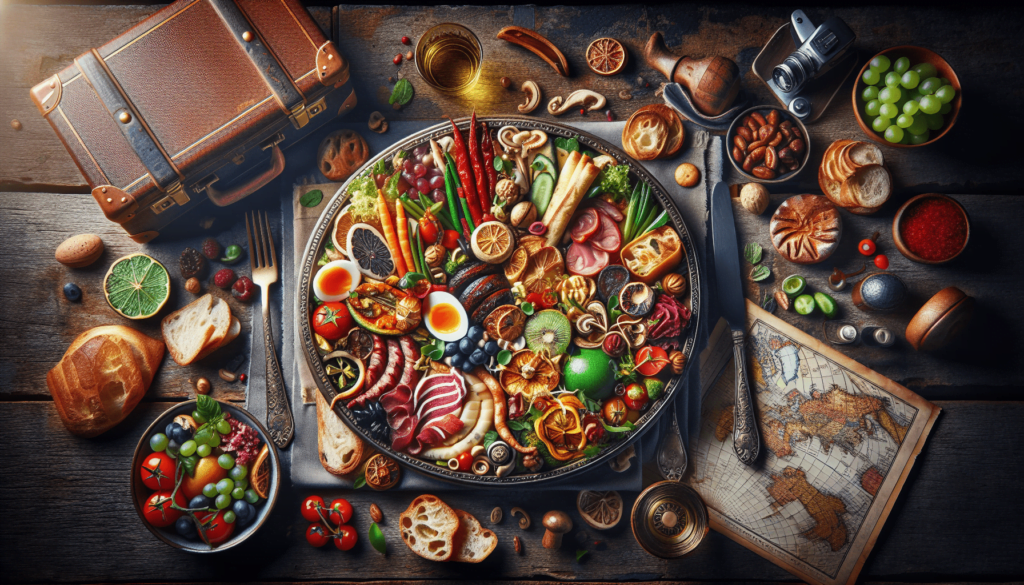Take a journey through “Delicious Discoveries: Exploring Authentic Cuisines on the Road,” where you will uncover the profound and delectable ways that food enriches your travel experiences. This article delves into the rich historical backgrounds of various cuisines, shedding light on the unique flavors that define different cultures. Together, we will explore current trends in culinary tourism, offering key insights into how food and travel intertwine to create unforgettable adventures.
Through detailed examples and case studies, you’ll understand the significance of seeking authentic culinary experiences while traveling, as well as the broader implications these adventures have on society and local economies. As you continue this gastronomic journey, savor the anticipation of discovering what future culinary trends may emerge and how they will shape your traveling endeavors. Dive in and let your taste buds lead the way to unforgettable destinations! Have you ever found yourself on a road trip, hunger gnawing at your insides, and wondered what culinary delights the unfamiliar landscape might offer?
Table of Contents
Exploring Authentic Cuisines
Overview
Traveling isn’t just a journey from point A to point B; it’s an adventure packed with discoveries, experiences, and moments that make the trip memorable. Among those experiences, the exploration of authentic local cuisines stands out. When you hit the road and delve into the unique flavors each destination has to offer, you inadvertently open doors to the culture, history, and soul of that region.
Thesis Statement
This article will explore the thrilling journey of discovering authentic cuisines during road trips, shedding light on the historical and cultural contexts, current trends, and impactful experiences that form an integral part of our travel adventures. Buckle up, as we embark on this flavorful journey!

Historical Context
Before modern transportation and globalization, regional cuisines evolved from local resources and cultural traditions. In ancient times, travelers depended on local food as they traversed geographic areas, tasting the land’s bounty. Consider the medieval Silk Road – travelers experienced an exchange of culinary practices along with goods, with spices, tea, and fruits passing from one region to another.
Similarly, the American road trip culture post-WWII sparked a surge in roadside diners, each offering tastes of the local terrain. These eateries became waypoints, mapping America’s gastronomic diversity.
Regional Cuisine Evolution
- Asia: The Silk Road brought spices and unique ingredients from one land to another.
- Europe: Journeying through France meant tasting the terroir in wines and cheeses.
- America: The post-war era saw the rise of diverse diners along highways.
Current Trends
Nowadays, the travel culinary scene has evolved with food tourism becoming a focal point. From farm-to-table experiences to food trucks offering gourmet culinary treats, the contemporary traveler is presented with a myriad of options to explore authentic flavors.
Culinary Tourism
Food tourism is not just about eating; it’s about experiencing food as a way to understand the place you’re visiting. Whether it’s indulging in street food in Bangkok, savoring tapas in Spain, or trying BBQ in Texas, culinary tourism amplifies your travel experience.
- Food Festivals: Events like the Pizzafest in Naples or the Ramen Expo in Tokyo highlight local specialties.
- Farm Visits: Engage in farm-to-table dining where you eat fresh produce right where it’s grown.
- Street Food Markets: Marketplaces around the world, such as Borough Market in London, provide an authentic taste of local flavors.

Key Concepts and Definitions
To ensure you’re on the same page, let’s define some essential concepts.
Authentic Cuisine
Authentic cuisine refers to traditional foods that reflect the cultural, historical, and agricultural heritage of a region. It’s food that’s prepared using age-old recipes and local ingredients.
Food Tourism
Food tourism, also known as culinary tourism, involves exploring a destination through its culinary offerings. This could include dining experiences, food tours, cooking classes, and visits to local markets and food producers.
Term Breakdown
- Gastronomy: The study of food and culture, particular to a certain region.
- Terroir: The set of all environmental factors that affect a crop’s qualities, essentially translating to ‘taste of a place.’
- Locavore: Someone who predominantly eats food that is locally produced, not moved long distances to market.
Detailed Exploration
Example 1: Southern United States – BBQ Road Trips
Imagine driving through the Southern United States, where BBQ is not just food but a tradition passed down through generations. Each state might boast its own unique style – from the vinegar-based sauces of North Carolina to the dry rubs of Texas.
When stopping at a popular BBQ joint in North Carolina, you might learn that the rich flavor of their pork comes from wood-smoked techniques dating back centuries. The experience is enriched by understanding the historical context, from preserving meat to community gatherings.
BBQ Styles:
- Carolina BBQ: Emphasizes pork, with variations such as vinegar-based or mustard-based sauces.
- Texas BBQ: Known for beef, particularly brisket, seasoned with a dry rub and slow-cooked.
- Kansas City BBQ: Uses a wide variety of meats and is characterized by a thick, sweet, and tangy tomato-based sauce.
Example 2: Italy – A Culinary Road Atlas
Now picture traversing Italy by car, weaving through regions celebrated for their unique culinary contributions. In Emilia-Romagna, you may savor authentic Parmigiano Reggiano cheese and balsamic vinegar, each bite connecting you to centuries of tradition.
When you stop at a trattoria in Tuscany, the simple yet robust flavors of Panzanella salad reflect the region’s reverence for seasonal ingredients. Your journey from Naples to Roma might introduce you to the delightful contrasts of Neapolitan pizza and Roman pasta.
Culinary Stops:
- Naples: Sample Margherita pizza, the epitome of Italian simplicity.
- Tuscany: Relish in Ribollita and other rustic, farm-to-table dishes.
- Sicily: Indulge in Cassata and other unique sweet treats influenced by Mediterranean cultures.
Comparison of Different Perspectives
Traditional vs. Modern Interpretations
In each gastronomic journey, you’ll find traditional eateries preserving age-old recipes and modern establishments innovating new culinary blends.
Traditional Venues
- Michele’s Pizza in Naples: A place preserving the legacy of Neapolitan pizza.
- Lockhart BBQ in Texas: An establishment holding to time-honored BBQ practices.
Modern Interpretations
- Pizzarium in Rome: Offers gourmet pizza slices incorporating contemporary ingredients.
- Franklin Barbecue in Austin: Combines traditional smoking techniques with modern culinary twists.
Impact Assessment
The differing perspectives form a holistic picture of a region’s culinary landscape. Traditional venues give you a taste of history, while modern eateries show how cuisine evolves and stays relevant.
By embracing both, travelers gain a comprehensive understanding of local food culture. These experiences can lead to increased appreciation for diversity and inspire culinary creativity back home.
Future Directions and Implications
Predictions
As culinary tourism continues to grow, expect more integrated food experiences. Virtual reality food tours, augmented reality cooking classes, and interactive culinary museums are on the horizon, expanding the ways travelers can engage with local cuisines.
Implications
These trends not only amplify our travel experiences but also highlight the importance of sustainable food practices. As more people seek authentic food experiences, the demand for locally-sourced, organic ingredients is likely to rise, encouraging sustainable agriculture and preservation of culinary heritages.
Conclusion
Recap
Exploring authentic cuisines on the road is more than satisfying your hunger; it’s about delving into the local culture, history, and traditions. From tasting vinegary BBQ in North Carolina to indulging in a perfect pizza in Naples, these experiences enrich your travel journey.
Final Thought
So, next time you find yourself on the road pondering what to eat, ask yourself: What story does this dish tell about the place you are in?
Engagement
We’d love to hear about your culinary adventures on the road! Share your experiences and favorite food discoveries in the comments and inspire fellow travelers to taste the world.
Credible Sources
- Pollan, M. (2006). The Omnivore’s Dilemma. Penguin Press.
- Cheney, K. (2020). Field to Feast: The Culinary Road Trip of a Lifetime. Whitecap Books.
- Long, L. M. (2004). Culinary Tourism. University Press of Kentucky.
- The World’s 50 Best Restaurants (Website)
- UNESCO (Website on Intangible Cultural Heritage)
Indulge in the journey and savor every bite – happy travels and bon appétit!
Related site – Delicious Discoveries: Exploring Local Cuisine Around the World
